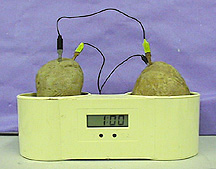
Monday, April the 10th, 2006
back to: title, date or indexes
(Text of a paper given at the Fifteenth International Symposium Of Potato Chronometry, held in Ülm, Spring 2006)
Helsinki or Ülm? Helsinki or Ülm? That was the question faced by our colleagues on the Steering Committee when wrestling with the problem of where to hold this, our fifteenth symposium. And I mean “wrestling”, for that is how the matter was eventually decided. Winterbag represented the Ülmites, and Ah Fang the Helsinkiistas, and they fought a bout, each round of which was of course timed by a potato clock.
In round one, Winterbag came out on top, making use of a butterfly, reverse crucifix, lady of the lake and octopus hold. Round two saw him further the cause of the Ülmites with some decisive inverted facelock camel clutches, tiger feint crucifix armbars, a chicken wing, beast choker, and a Tongan death grip. It looked as if our symposium was certainly headed for this fair German city. But in round three, Ah Fang rallied, with a two handed choke lift, an Argentine leglock, spinning toe hold, sharpshooter, clawhold, front chancery, stretch plum, pearl river plunge, mount, scoop and pump handle. He pushed home his advantage in round four, with a tilt-a-whirl and a tree of woe. Winterbag got his breath back, however, and in the final round won the match with a fish hook, sunset flip, Texas cloverleaf, gory special, Fujiwara armbar, hammerlock, sitting double chicken wing, anaconda vice, a wheelbarrow, and a Haas of Pain. It was all over, and the symposium was headed for Ülm.And here we are!
There has never been a better time to sing the praises of potato chronometry. In a world threatened by bird flu, climate change, the depletion of oil reserves, terrorism, poverty, war, David Blunkett, and fundamentalisms of every stripe, we may yet have faith in the simple potato. A generation ago, in the doomed upheavals of 1968, the call was for “Power To The People!” Had those naïve revolutionaries called for “Power To The Potato!” things would be very different today.
For potatoes, as we know, have power. Which of us here in this splendidly-appointed conference centre in Ülm has not, at one time or another, taken two common galvanized nails, three alligator clip/wire units (that is, alligator clips connected to one another with wire), two short pieces of heavy copper wire, a simple low-voltage LED clock unit, and two potatoes, and obtained a simple LED clock unit that functions from the power of a 1- to 2-volt, button-type battery, opened the battery compartment to remove the battery, noted that there is a positive (+) and a negative (-) terminal point where the battery was installed, identified the potatoes as number one and number two, inserted one nail in each potato, inserted one short piece of heavy copper wire in each potato, placing it as far from the nail as possible, used one alligator clip/wire to connect the copper wire inserted in potato number one to the positive terminal in the clock unit, then used one alligator clip/wire to link the nail in potato number two to the negative terminal in the clock unit, used the final alligator clip/wire to link the nail in potato number one to the copper wire in potato number two, and finally, with no little sense of triumph, set the clock a-ticking? Which of us has not harnessed the power of the potato to control time?

The history of potato clocks is the subject of Dobson's magnificent pamphlet On The History Of Potato Clocks. Sadly, it is out of print. Those of you lucky enough to have read it will know that it caused a good deal of controversy among the experts, sharply dividing the world of potato chronometry into two hostile camps. Broadly speaking, there were the potato-ists, who held that the defining characteristic of the potato clock is its “potato-ness”, vying with the clockists, who are wedded to the idea that the keeping of accurate time is the crux of the matter. Dobson himself refused to take sides, arguing with some elegance that both potato and clock are equally important in what it means to be a potato clock. This assertion itself led to a slew of letters and articles in the specialist press, accusing Dobson of preposterous arrogance.
The pamphleteer, thundered one anonymous correspondent, claims that he knows what it is like to be a potato clock. This is arrant twaddle. A potato clock is made of potatoes and a few bits of wire and other things. Dobson is simply a flawed biped, and one whose brain is obviously not working properly.
Where does this leave us? We stand at the dawn of a new millennium, one in which the potato clock will have a decisive part to play, even if we do not yet know with any precision what that part will be. Is our perception of time, as measured by potatoes, qualitatively different, better or worse than other methods of keeping time, more or less attuned to nature, to the cycle of the seasons, to the sun and the moon and the stars, to the tides of the sea and the life cycle of beings both tiny and huge? We need to answer these questions with some urgency, and that is why I propose that we storm the gates of all those remote and secretive buildings where so-called atomic clocks with their pinpoint accuracy are ticktocking away, and we wrench them from their fixtures and stamp them to bits under our big boots, and we replace them all with potato clocks. I, for one, foresee our triumph.
Thank you. My next lecture will take place in the pie shop annexe where I will be addressing the exciting topic Measuring Distance By Laying Celery Sticks End To End.
Hooting Yard on the Air, April the 21st, 2016 : “That Dobson-hubbard Slur” (starts around 06:31)